Kenya Certificate of Primary Education 2017 Science
1.The diagram below shows an equipment used to separate a mixture of solids.

The method of separation in which the equipment is used is
A. winnowing
B. picking
C. sieving
D. filtration.
2.In which one of the following activities is the tool used properly?
A. Splitting firewood using a jembe.
B. Cutting wires using a knife.
C. Using a saw to cut wood.
D. Breaking stones using a claw hammer.
3.The heat from a burning charcoal stove reaches the other parts of a room mainly by I
A. radiation and conduction;
B. radiation only;
C. radiation and convection;
D. convection only.
4.Which one of the following characteristics is found in both tilapia and ducks?
A. Have scales.
B. Filter feeding.
C. External fertilisation.
D. Breathing under water.
5.Which one of the following statements is correct about water?
A. Filtration makes water safe for drinking.
B. Boiled hard Water is safe for drinking.
C. Sofl water should not be boiled before drinking.
D. Boiling makes hard water difiicult to lather.
6.Which one of the following statements is TRUE about HIV and AIDS‘?
A. An individual in asymptomatic stage of HIV infection tests negative.
B. A person develops AIDS during the window period of HIV infection.
C. An individual infected with HIV does not necessarily have AIDS.
D. I-[IV can be spread by mosquito bites.
7.Which one of the following practices conserves water by using sparingly?
A. Washing cars along the lake shore.
B. Potuing water in the garden after washing fruits.
C. Watering animals in rivers.
D. Carrying out drip irrigation.
8.The following signs and symptoms were observed on a patient:
(i) Severe headache
(ii) Abdominal pain
(m) Fever
(iv) Slight diarrhoea with blood stains
(v) Sores in the mouth.
9.The patient is likely to be suffering from
A. malaria
B. typhoid
C. cholera
D. bilharzia.
10.Which one of the following attaches itself on the uterus wall to develop into a baby?
A. Ovum.
B. Foetus.
C. Embryo.
D. Zygote.
11.Which one of the following is NOT a reason for HIV testing?
A. To know the number of people infected.
B. For future planning.
C. To be keen to protect yourself and others.
D. In order to avoid infected individuals.
11. The table below shows the results of an investigation done by pupils on floating and sinking.
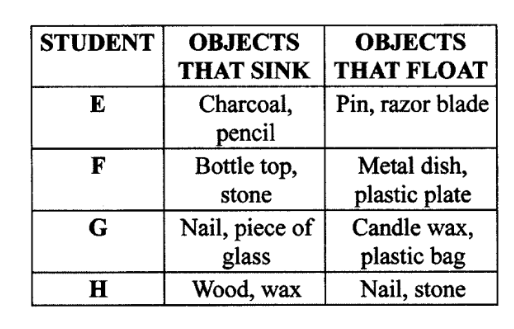
The pupil who recorded the correct results was
A.E
B.F
C.G
D.H
12. Which one of the following parts of the human digestive system is correctly matched to its function?
ORGAN
FUNCTION
A. Mouth Digests proteins.
B. Stomach Secretes digestive juice
C. Small intestines Absorbs water
D. Large intestines Stores digested food
13. The diagram below shows a certain animal parasite.

The parasite belongs to the same group as
A. Tapeworm and liver fluke;
B. Roundworm and flea;
C. Tsetse fly and tapeworm;
D. Flea and tsetse fly.
14.Which of the following is NOT advisable for a patient suffering from tuberculosis‘?
A. Ventilated housing.
B. Vaccination against the disease.
C. Isolation from healthy people.
D. Early treatment with antibiotics.
15.The diagram below demonstrates an experiment done by pupils to show a certain type of soil erosion.
box
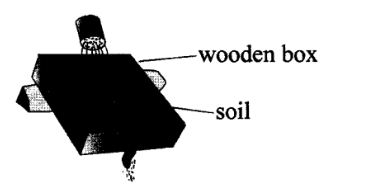
The type of soil erosion demonstrated by the pupils was
A. splash erosion
B. gulley erosion
C. rill erosion
D. sheet erosion.
16.Which one of the following pairs of plants stores food in the root‘?
A. Carrots and irish potatoes.
B. Irish potatoes and sweet potatoes.
C. Sweet potatoes and cassava.
D. Cassava and onions.
17.The diagram below represents the proportion of gases in air.

Which proportion represents the gas used in seed germination?
A.J
B.k
C.L
D.M
18.Which one of the following nutritional deficiency diseases makes the face and limbs of a child to swell?
A. Anaemia.
B. Marasmus.
C. Rickets.
D. Kwashiorkor.
19.Which one of the following pairs consists only of sources of electricity?
A. Wind driven turbine and electric water heater.
B. Electric water heater and generator.
C. Generator and electric iron box.
D. Bicycle dynamo and wind driven turbine.
20.Which one of the following levers has the effort between the fulcrum and the load when in use?
A. Wheelbarrow.
B. Spade.
C. Crowbar.
D. Claw hammer.
21.The chart below shows a simple classification of animal feeds.
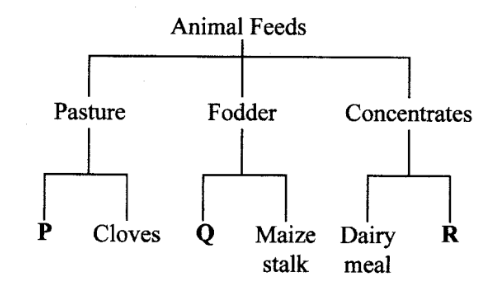
A. Lucerne Napier Chick grass mash
B. Desmodium Calf pellets Salt licks C. Sweet Sorghum Hay
potatoes vines
D. Lucerne Desmodium Layers mash
22.A plant has the adaptations below:
(i) thin cuticle
(ii) flexible stems
(m) air sacs
(iv) waxy upper leaf surface.
The plant is likely to be a
A. cactus.
B. water lily.
C. sorghum.
D. bean.
23.Pupils put garden soil in a glass bottle containing Water, shook it and allowed it to settle. Which one of the following could NOT be determined by the experiment?
A. Presence of air.
B. Presence of organic matter.
C. Presence of inorganic matter.
D. Sizes of different soil particles.
24.Which one of the following is a function of fibre in the human diet?
A. Helps in food digestion.
B. Helps in the absorption of digested food.
C. Prevents diarrhoea.
D. Removal of undigested materials.
25.Which one of the following pairs consists only of green plants.
A. Moss and fem.
B. Toadstool and moss.
C. Algae and mould.
D. Mould and fern.
26.The following are parts of a flower
(i) anther.
(ii) style.
(m) ovary.
(iv) stigma.
Which pair of the plant parts is involved in pollination?
A. (i) and (m)
B. (ii) and (m)
C. (m) and (iv) D. (i) and (iv)
27.In an investigation, pupils placed a mirror in a basin containing water to direct light to a white wall. The pupils were investigating
A. how light travels.
B. reflection.
C. refraction.
D. making of a rainbow.
28.Which one of the following groups of materials consists only of non-magnetic materials.
A. Nickel, aluminium, copper.
B. Plastic, copper, aluminium.
C. Paper, iron, glass.
D. Staples, coal, iron.
29.During an experiment pupils poured a certain amount of water into a container labelled S. They then transferred the same water into the containers labelled T and V.
The pupils were investigating whether liquids
A. have definite shape.
B. have definite volume.
C. occupy space.
D. exert same pressure.
30. Pupils set up an experiment as shown in the diagram below.
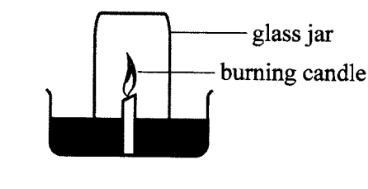
Which one of the following was a correct observation from the experiment?
A. Water level in the trough increased.
B. Candle flame brightened.
C. Water level in the jar increased.
D. Colour of the water changed.
31.The diagram below represents a set—up used to demonstrate certain aspects of matter.
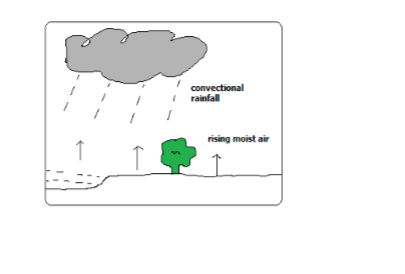
The pin next to the candle fell off’ as a result of
A. conduction and radiation.
B. radiation only.
C. convection and conduction.
D. conduction only.
32.Which one of the following components of the environment will be least affected when an oil pipe bursts?
A. Air.
B. Water.
C. Soil.
D. Plants.
33.Pupils placed a bottle top on water and it floated. They then crushed and placed the same bottle top on the water again and it sunk.
Which one of the following factors that affect sinking and floating was being investigated?
A. Size of the material.
B. Type of the material.
C. Shape of the material.
D. Mass of the material.
34.The diagram below represents a single fixed pulley in use.
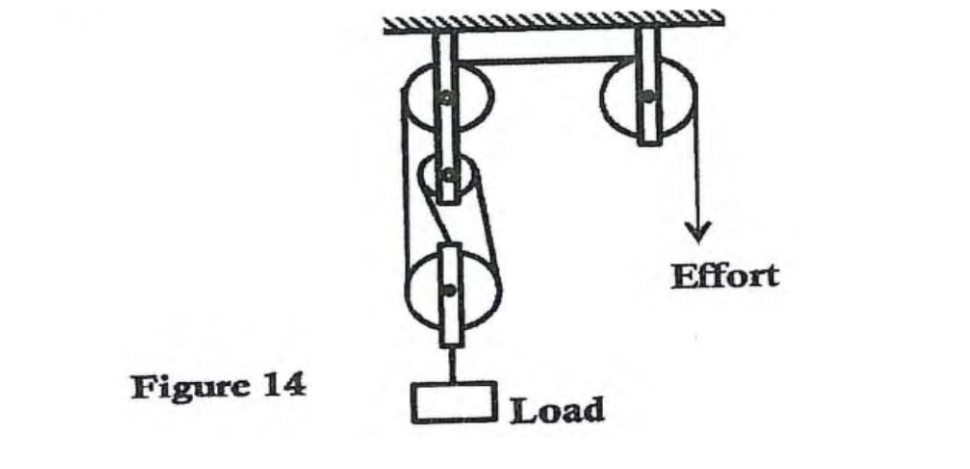
Which one of the following is NOT true about the pulley? .-
A. It reduces the effort applied.
B. Effort and load move through equal distances.
C. Makes work easier by changing direction of effort.
D. The wheel reduces friction.
35.The diagram below lllustrate balancing against one.
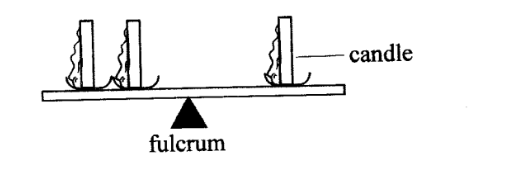
If all the candles were lit at the same time, which one of the following is a correct observation made in the experiment?
A. The two candles were displaced upwards.
B. The single candle was displaced upwards.
C. There was no change in the set up.
D. The see-saw will swing towards both sides.
36.Which one of the following methods of food preservation is NOT modern’?
A. Canning.
B. Drying.
C. Use of honey.
D. Refrigeration.
37.Which type of manure is common on dairy farms‘?
A. Green manure.
B. Compost manure.
C. Farmyard manure.
D. Organic mulehes.
38.During digestion, the following activities occur in the mouth EXCEPT
A. mechanical breakdown of food.
B. secretion of digestive juice.
C. killing of germs.
D. rolling of food into bolus.
39.Which one of the follovwng pairs of diseases is the infant immunised against at birth?
A. Tuberculosis and polio.
B. Polio and diphtheria.
C. Diphtheria and yellow fever.
D. Tuberculosis and yellow fever.
40. Which one of the following teeth problems can be prevented by feeding on a balanced diet?
A. Bleeding gums.
B. Dental cavities.
C. Bad smell.
D. Tooth decay.
41. Which one of the following plants is a cash crop?
A. Sunflower.
B. Irish potato.
C. Wheat.
D. Pineapple.
42. The chart below shows a weather record kept by pupils for five days.

From the chart, whenever it was
A. sunny in the morning, it rained in the afternoon.
B. cloudy in the morning, it was sunny in the aflemoon.
C. calm in the morning, it was windy in the afiemoon.
D. windy in the moming, it was calm in the afternoon.
43. Below is an illustration of a food chain.
Plant —> Antelope —> Lion —> Vulture Tertiary consumers are represented by
A. plants.
B. antelope.
C. lion.
D. vulture.
44. Which one of the following planets is closer to the sun?
A. Jupiter.
B. Venus.
C. Earth.
D. Mars.
45. The diagram below shows the human digestive system.
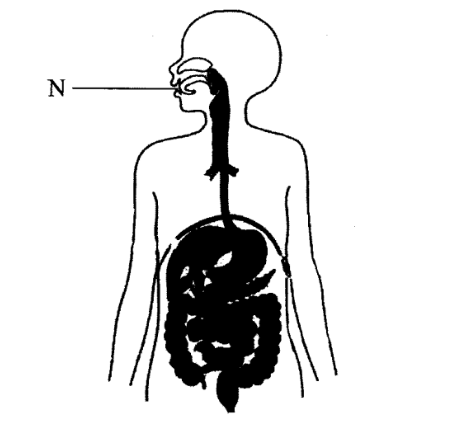
The juice produced at the part labelled N is used to digest
A. carbohydrates.
B. proteins.
C. fats and oils.
D. mineral salts.
46.The table below shows the type and number of teeth in an adult human being.

The diagram below represents a mammalian heart.

In which pair of blood vessels is blood under highest pressure?
A. WandX.
B. XandY.
C. YandZ.
D. WandZ.
48. The diagram below shows components of human blood.
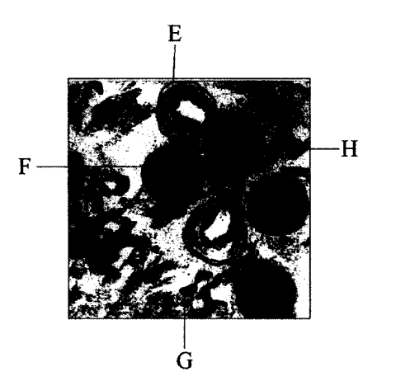
The component that stops the bleeding of a wound is .
A.E
B.F.
C.G
D.H
49.Which one of the following is NOT an excretory product in human beings?
A. Urine.
B. Faeces.
C. Sweat.
D. Carbon dioxide.
50.Which one of the following is a function of the amniotic sac during pregnancy?
A. Passes digested food to the foetus.
B. Allows gaseous exchange between the mother and foetus.
C. Prevents harmful micro-organisms from reaching the foetus.
D. Protects the foetus from physical shock.
2017 Science Questions and Answers
1.The diagram below shows an equipment used to separate a mixture of solids.

The method of separation in which the equipment is used is
C. sieving
2.In which one of the following activities is the tool used properly?
C. Using a saw to cut wood.
3.The heat from a burning charcoal stove reaches the other parts of a room mainly by
C. radiation and convection;
D. convection only.
4.Which one of the following characteristics is found in both tilapia and ducks?
A. Have scales.
5.Which one of the following statements is correct about water?
B. Boiled hard Water is safe for drinking.
6.Which one of the following statements is TRUE about HIV and AIDS‘?
C. An individual infected with HIV does not necessarily have AIDS.
7.Which one of the following practices conserves water by using sparingly?
D. Carrying out drip irrigation.
8.The following signs and symptoms were observed on a patient:
(i) Severe headache
(ii) Abdominal pain
(m) Fever
(iv) Slight diarrhoea with blood stains
(v) Sores in the mouth.
The patient is likely to be suffering from
B. typhoid
9.Which one of the following attaches itself on the uterus wall to develop into a baby?
C. Embryo.
10.Which one of the following is NOT a reason for HIV testing?
D. In order to avoid infected individuals.
11. The table below shows the results of an investigation done by pupils on floating and sinking.

The pupil who recorded the correct results was
C.G
12. Which one of the following parts of the human digestive system is correctly matched to its function?
ORGAN FUNCTION
B. Stomach Secretes digestive juice
13. The diagram below shows a certain animal parasite.

The parasite belongs to the same group as
D. Flea and tsetse fly.
14.Which of the following is NOT advisable for a patient suffering from tuberculosis‘?
B. Vaccination against the disease.
15.The diagram below demonstrates an experiment done by pupils to show a certain type of soil erosion.
box

The type of soil erosion demonstrated by the pupils was
C. rill erosion
16.Which one of the following pairs of plants stores food in the root‘?
C. Sweet potatoes and cassava.
17.The diagram below represents the proportion of gases in air.

Which proportion represents the gas used in seed germination?
A.J
18.Which one of the following nutritional deficiency diseases makes the face and limbs of a child to swell?
D. Kwashiorkor.
19.Which one of the following pairs consists only of sources of electricity?
D. Bicycle dynamo and wind driven turbine.
20.Which one of the following levers has the effort between the fulcrum and the load when in use?
B. Spade.
21.The chart below shows a simple classification of animal feeds.

The feeds labelled pqr can be best be represented by P Q R A. Lucerne Napier Chick grass mash
22.A plant has the adaptations below:
(i) thin cuticle
(ii) flexible stems
(m) air sacs
(iv) waxy upper leaf surface.
The plant is likely to be a
B. water lily.
23.Pupils put garden soil in a glass bottle containing Water, shook it and allowed it to settle. Which one of the following could NOT be determined by the experiment?
A. Presence of air.
24.Which one of the following is a function of fibre in the human diet?
D. Removal of undigested materials.
25.Which one of the following pairs consists only of green plants.
A. Moss and fem.
26.The following are parts of a flower
(i) anther.
(ii) style.
(m) ovary.
(iv) stigma.
Which pair of the plant parts is involved in pollination?
D. (i) and (iv)
27.In an investigation, pupils placed a mirror in a basin containing water to direct light to a white wall. The pupils were investigating
A. how light travels.
28.Which one of the following groups of materials consists only of non-magnetic materials.
B. Plastic, copper, aluminium.
29.During an experiment pupils poured a certain amount of water into a container labelled S. They then transferred the same water into the containers labelled T and V.
The pupils were investigating whether liquids>
A. have definite shape.
30. Pupils set up an experiment as shown in the diagram below.

Which one of the following was a correct observation from the experiment?
C. Water level in the jar increased.
31.The diagram below represents a set—up used to demonstrate certain aspects of matter.

The pin next to the candle fell off’ as a result of
C. convection and conduction.
32.Which one of the following components of the environment will be least affected when an oil pipe bursts?
A. Air.
33.Pupils placed a bottle top on water and it floated. They then crushed and placed the same bottle top on the water again and it sunk.
Which one of the following factors that affect sinking and floating was being investigated?
C. Shape of the material.
34.The diagram below represents a single fixed pulley in use.

Which one of the following is NOT true about the pulley? .-
A. It reduces the effort applied.
35.The diagram below lllustrate balancing against one.

If all the candles were lit at the same time, which one of the following is a correct observation made in the experiment?
C. There was no change in the set up.
36.Which one of the following methods of food preservation is NOT modern’?
C. Use of honey.
37.Which type of manure is common on dairy farms‘?
C. Farmyard manure.
38.During digestion, the following activities occur in the mouth EXCEPT
C. killing of germs.
39.Which one of the following pairs of diseases is the infant immunised against at birth?
A. Tuberculosis and Polio.
40. Which one of the following teeth problems can be prevented by feeding on a balanced diet?
A. Bleeding gums.
41. Which one of the following plants is a cash crop?
A. Sunflower.
42. The chart below shows a weather record kept by pupils for five days.

From the chart, whenever it was
D. windy in the moming, it was calm in the afternoon.
43. Below is an illustration of a food chain.
Plant —> Antelope —> Lion —> Vulture Tertiary consumers are represented by
D. vulture.
44. Which one of the following planets is closer to the sun?
A. Jupiter.
B. Venus.
45. The diagram below shows the human digestive system.

The juice produced at the part labelled N is used to digest
A. carbohydrates.
46.The table below shows the type and number of teeth in an adult human being.

47.The diagram below represents a mammalian heart.

In which pair of blood vessels is blood under highest pressure?
B. XandY.
48. The diagram below shows components of human blood.

The component that stops the bleeding of a wound is .
C.G
49.Which one of the following is NOT an excretory product in human beings?
B. Faeces.
50.Which one of the following is a function of the amniotic sac during pregnancy?
D. Protects the foetus from physical shock.
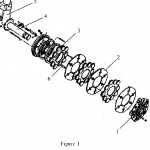

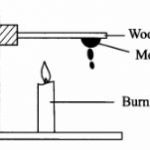
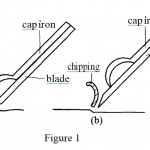

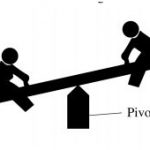
Hello? I would like to join this group so as to get daily revision,can i?
Yes